Toxic shower water. Sewage pits. ‘Infuriating’ woes in east Coachella Valley mobile parks
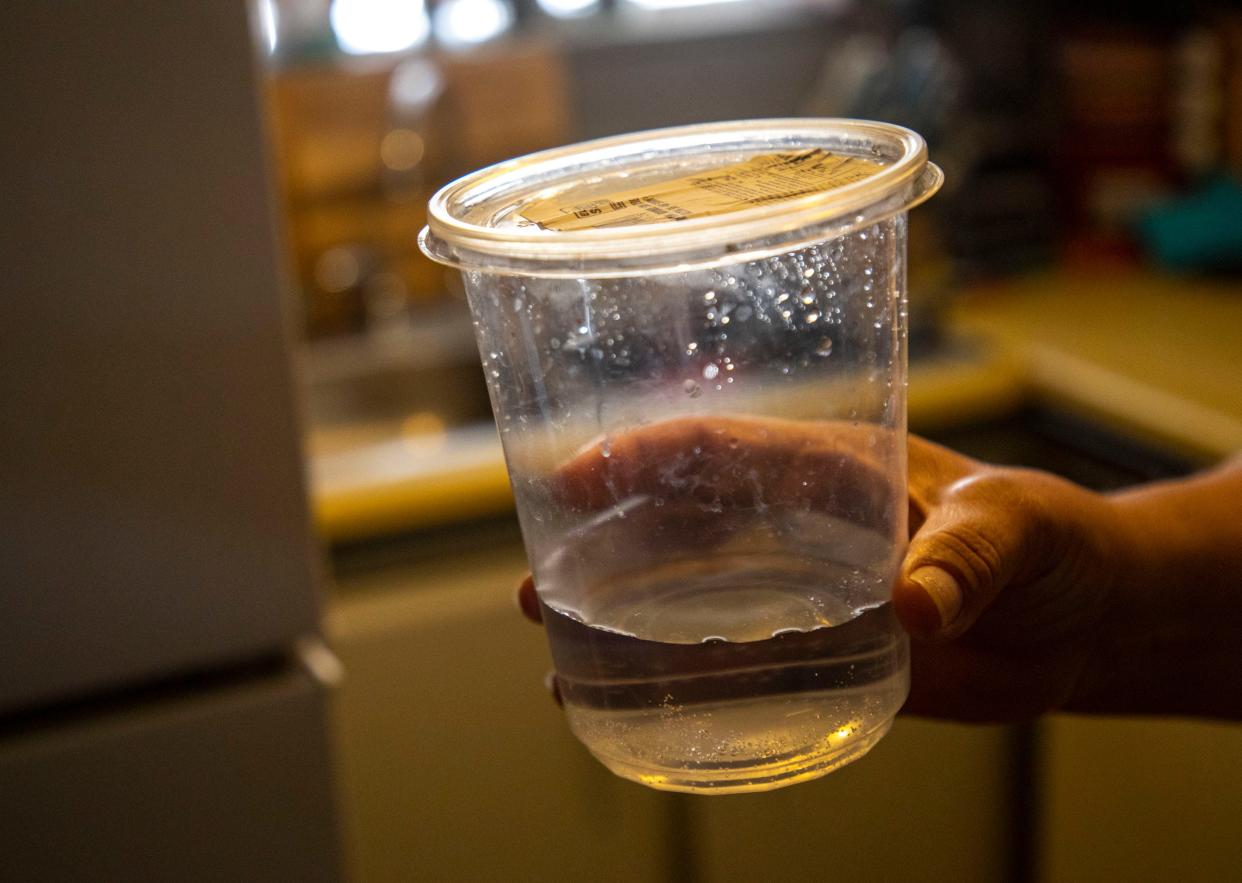
After a long day picking peaches in heat near 90 degrees, farmworker Jose Castellanos sat sweating and drinking a beer outside his dilapidated but tidy mobile home in Thermal. Taking a shower wasn’t a safe option: A notice he got from the U.S. Environmental Protection Agency in late March warned his family that their tap water should not be used for cooking and was bad for their teeth and hair.
Arellano Mobile Home Park, where the Castellanos live, is one of seven east Coachella Valley trailer parks where since November EPA inspectors have found water containing arsenic levels above federal legal limits — even from a faucet equipped with a filter — and thousands of times above state public health guidelines. Low-income residents at the small park and others like it told The Desert Sun they've long endured foul-smelling water and have had to buy gallons of clean water for years to try to stay safe.
“In the early mornings is when it’s worse, because we open the faucet and it looks dirty. It smells rotten and it looks like it has sand in it. We have to let it run for a while,” said Castellanos, who has lived at the park for 12 years. The 59-year-old works seasonal jobs in often triple-digit heat at nearby farms, earning just under $20,000 annually.
“We don’t like the situation, but nobody listens to us,” Castellanos said. “We have to use the faucet water. What else are we supposed to do? We can’t buy that much water.”
The mobile home park's owner, Adela Arellano, did not respond to a request for comment.
Thousands of people live in more than 115 small trailer parks and camps in Oasis, Mecca, Thermal and other areas of the east valley, according to data from the Coachella Valley Water District, EPA and others. Many are on Torres Martinez tribal lands.
While most Americans turn on their faucets and showers without much thought, farmworkers and other low-income residents in rural areas like these are often stuck with aging septic systems that malfunction and old water wells tainted with potentially toxic types of arsenic and other chemicals.
"We have over 1 million Californians that don't have access to safe water in the state, and they're located in virtually every county of the state,” said Kelsey Hinton, spokeswoman for Community Water Center, which helps low-income communities advocate for water solutions. Hinton said Coachella Valley, Central Valley and Central Coast agricultural areas are where the problem is the worst.
Even after a decade of efforts to install modern water quality and sewage systems in the eastern Coachella Valley, including comprehensive mapping and planning, little has actually been fixed. While new luxury housing developments and now proposed surf wave parks and lagoon resorts quickly obtain promised water supply, efforts have dragged on for years to bring safe water to some of the valley's poorest inhabitants. CVWD officials and federal regulators blame restrictive or weak water laws and lack of funding, but some experts and elected officials say they could be doing more.

“It infuriates me. These injustices and these disparities, it infuriates me,” said U.S. Rep. Raul Ruiz (D-LaQuinta), who as an emergency room and community doctor has seen young patients with stunted growth and delayed cognitive development, families with diabetes, older women with bladder cancers, and aging men stooped in pain from untreated prostate cancer.
Those conditions have all been linked by researchers to years of exposure to inorganic arsenic, which officials say occurs naturally in the soil and groundwater in parts of the Coachella Valley. But that and other types of arsenic from old pesticides, treated wood and other former agricultural uses can also leach into wells, experts say. Exposure to large amounts of arsenic can also cause rashes, skin disorders or even coma or death.
While it usually takes a decade or more for symptoms to appear, and multiple factors can cause serious disease, “it is clear that arsenic at unhealthy levels is in the water. It is clear that the residents of these various mobile home parks have been drinking that water with high arsenic, and showering in it,” said Ruiz. “So it is clear that they are at risk for diabetes, cancers, rashes and other potential ailments.”
Ruiz, who serves on House Energy and Commerce subcommittees on Environment and Climate Change, Health, and Oversight and Investigations, added: “In Congress, the attention has been on cleaning pipes, to remove the lead in Detroit, Michigan, and other large cities. I continue to sound the alarm that rural America also has toxic drinking water.”

Years of effort, little progress
Awareness is growing, prodded by Ruiz and by Castulo Estrada, CVWD’s first Latino board member, who grew up in the east valley with limited clean water himself. A task force headed by Estrada was set up after he was elected in 2014, at age 26, on promises to tackle the problems.
By 2018, consultants for CVWD, the main potential water and sewage provider for the area, mapped more than 100 mobile home parks and camps and devised two East Coachella Valley master plans for at least 83 of them, one for water and one for sewage. The thrust of the plans is to lay new pipes to get the parks off polluted water wells and onto treated municipal supply, and build more pipes to connect the parks to existing sewage treatment facilities and eliminate aging septic systems. The new locations cited by EPA in the past four months will need to be added to the already daunting list.
Sewage is another major concern: In November, EPA inspectors found three large, open cesspools close to drinking water wells at Valladares Mobile Home Park in Thermal, where urine, feces and other wastewater continues today to be piped directly from seven units into the open-air pools, in violation of federal law. The owner, Patricia Valladares, could not be located for comment.
An estimated $212 million was needed as of 2018 for more than three dozen projects to consolidate neighboring mobile home park meters and systems into a large district, and construct and connect new water and sewage mains to existing infrastructure. Since then, costs have gone up significantly, a district spokeswoman said.
CVWD had $341 million in reserve funds at the start of this fiscal year, but district staff say Proposition 218, passed by state voters in 1996, prohibits them from spending a dime of funds from current customers on future customers, even low-income residents. That's largely true, say water experts. But Ellen Hanak, vice president and director of the Water Policy Center at the Public Policy Institute of California, also noted that under the law, reserve funds could be allocated if a majority of current customers voted to approve their use.
CVWD's board, long dominated by major farmers and representatives for golf course communities and other commercial development, has never sought such a vote.
“Our legal counsel has consistently advised that Prop. 218 prohibits us from using domestic water ratepayer funds to pay for infrastructure to connect new customers. As such, we have not had any discussions or votes in the past,” CVWD spokesman Scott Burritt said in an email to The Desert Sun.
Barring a change in their lawyers’ current stance, the district and county and state officials are instead concentrating on applying for grants, threading a thicket of detailed, often highly specific public funding sources, with some success. So far, about $22 million has been obtained in state and federal funds or is being finalized. Another $23 million is being sought from the California Water Resources Control Board, which is scheduled to vote on that application on April 19, and $8.8 million more is being sought via county allocations of federal funds. State water board staff will recommend the $23 million request be approved.
To date, Westside Elementary School, Thermal Mutual Mobile Home Park and Oasis Gardens Mobile Home Park, also in Thermal, have been hooked up to CVWD infrastructure with $3 million in state funds CVWD is also currently fixing an ion-exchange treatment plant at a Mecca domestic well site with $6 million in anticipated federal funds obtained via Riverside County Fourth District Supervisor V. Manuel Perez. Once the well and treatment plant are back in service, they will supply cleaner water to Mecca, North Shore and Bombay Beach. Another five of about 40 projects have been made top priorities on the district's master lists.
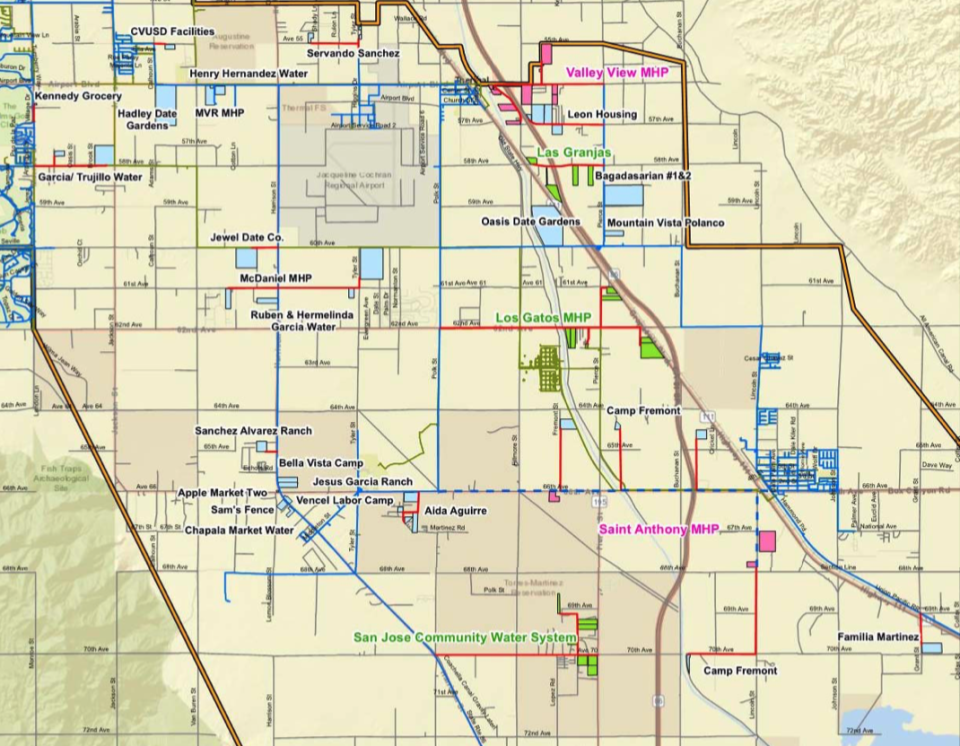
Some of the millions in public grants slowly being obtained to extend centralized water and sewage mains to poor areas could benefit future upscale developments in the area too. If infrastructure is built with taxpayer funds, and higher-end developments are later constructed nearby, those builders would not be legally obligated to reimburse the costs of any of the publicly funded infrastructure, a CVWD spokesperson said in an email.
‘Water is heavy’
In the east valley, even when people find a decent place to live, conditions can change overnight. For instance, residents of an unnamed mobile home park at 88-710 77th Ave. in Mecca said they had no issues with water for years. But a bad fire in March changed that. Half a dozen trailers burned, residents said, and while no people were injured, two dogs and a pet turtle died.
Since then, none of the units in the park have had running water. The Riverside County Fire Authority declined to comment or answer questions about whether they had enough supply to fight the blaze quickly. County Emergency Management Department spokesman Shane Reichardt confirmed there was a fire there on March 1.

He did not know the cause, but said water service was affected because the fire burned the electrical system that powered a pump for the park’s well. He said the owner lacks proper permits for the electric system, and was advised he needed to fix it. The owner, Carlos Cisneros, said in a phone interview that he could not comment on the cause of the fire due to legal matters. He also would not say if he's visited the park recently. He could not be reached to discuss the permits.
For weeks after the blaze, residents’ only access to water was from a truck from the Emergency Management Department, which delivered to them around 3 p.m. daily.
“Today, I ran out of water in the morning,” Lupe Garcia, 67, said at about 2 p.m. on March 23. “My son cleans pools around the valley, in La Quinta and Palm Desert, and I’ve given him buckets so he can ask his clients if he can get water from there.”
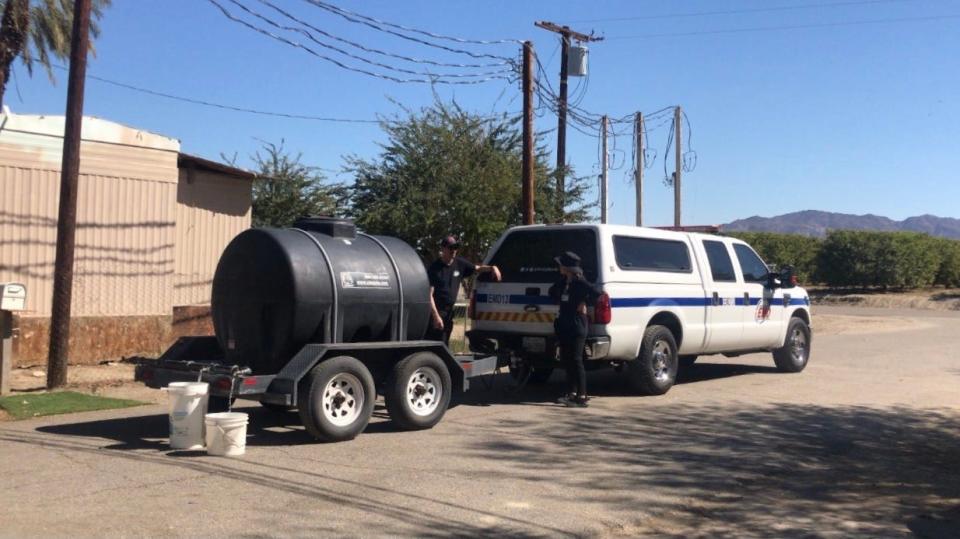
Garcia said she’s had no indication if or when her tap water will return. In the meantime, she’s had to change her routine, limiting her water intake and avoiding watering her plants. She is a farmworker, but said she also had to stop going to the fields in late March because carrying buckets and buckets of water back to her trailer has left her with constant back pain that won’t allow her to work.
“Water is heavy,” she said.
Other residents like Josefina and Rigoberto Gil now buy water. Rigoberto Gil said he goes to a market off Van Buren Street in Coachella to fill his truck with gallons of water, but that it’s difficult to buy enough.
The couple buys it mostly for laundry, and was using water from a county emergency truck to wash their food and dishes. Reichardt said his agency agreed to have an emergency water truck go to the site for two weeks, but that the owner asked for more time. On March 25, the truck stopped coming.
“We assisted with water, but it was intended to be a short-term assist,” Reichardt said. He said lack of water was a “wildcard,” and having it shut off for an entire community is rare. He estimated over 60 people have been left without it at the park.
For the Gils, it is a major concern that the park owner hasn’t shown up to talk about the fire, to update them on the situation or to tell them when they may have water again.
“I understand his property was burned and that is rough. I’d be willing to help with money, but not much, because I am also spending money on water now and the gas to drive to go get it,” Rigoberto Gil said.

Cisneros, the owner, said that nobody was injured in the fire and that the Red Cross is helping residents who were displaced. "The trailers were mine, so they just had their belongings there, like clothing, so that's all they lost."
Despite the lack of water, Gil said he, his wife, and their three children would like to stay. They formerly rented at a far worse spot — the long-troubled Oasis Mobile Home Park — before moving to Mecca a year ago in hopes of improving their living conditions.
"It’s calm here and we like our neighbors. We’re comfortable here,” he said. “But we can’t stay comfortable if the owner is going to be irresponsible.”
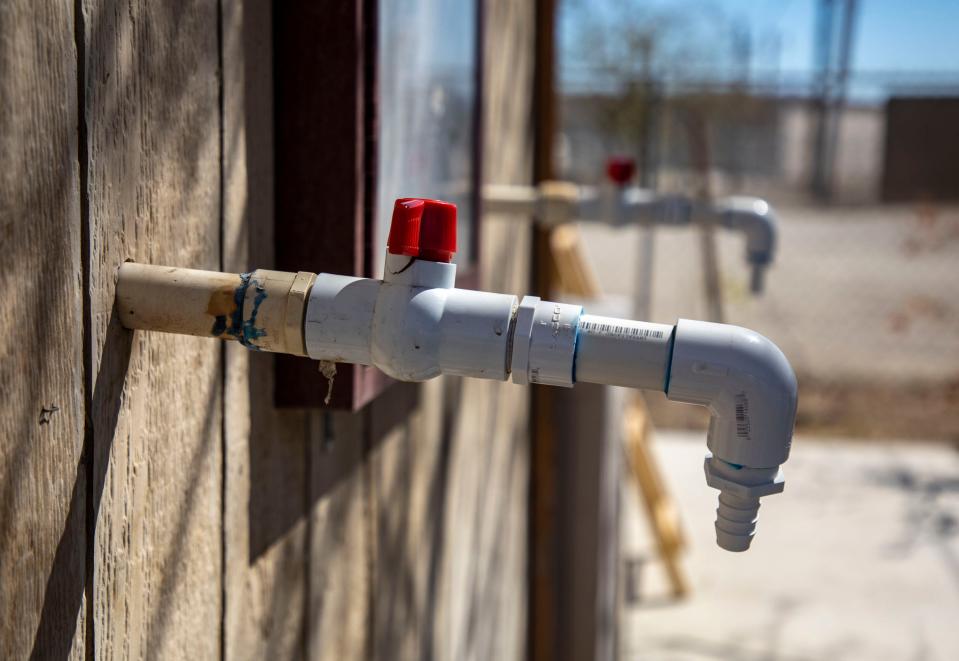
What are the feds doing?
Since President Joe Biden took office and declared environmental justice issues a priority, and since Central Valley community advocate Martha Guzman Aceves was appointed head of EPA’s Region 9 overseeing several western states, the agency has cracked down on small parks with dirty water and sewage woes in the eastern Coachella Valley.
Levels of arsenic at the seven parks cited by EPA in the past four months ranged from 14 parts per billion to as high as 83 parts per billion, well above the legal limit of 10 parts per billion, and thousands of times higher than the recommended state maximum, which is .004 parts per billion.
Under the emergency EPA orders, property owners must within 24 hours start to supply a gallon of clean water a day to each resident. Within two weeks, owners must submit a plan showing how they will clean the water of dangerous contaminants. Despite possible fines and other enforcement powers, though, EPA is receiving and approving compliance plans with no mandatory deadlines or even estimated dates of completion.

By law, the agency could seek court orders to fine owners nearly $25,000 per day per violation of the federal Safe Drinking Water Act. But the assistant director for the water branch in Region 9's Enforcement and Compliance Assurance Division, Roberto Rodriguez, said the agency prefers to work collaboratively with landowners and fellow agencies on solutions.
"For these cases, our number one goal is compliance, not penalizing the owners," Rodriguez said.
He said EPA staff consult regularly with Torres Martinez tribal officials and with county officials. Both have ceded authority over water and sewage issues to the federal agency, he said. A tribal spokesperson directed a request for comment on the state of the parks to park owners. Supervisor Perez's staff did not to respond to requests for comment or information about east valley mobile home parks.
Asked about years-long delays in getting clean water and proper sewage to area residents, Rodriguez said Coachella Valley mobile home parks are a high priority, but noted the agency has no legal authority to order specific remedies.
He said residents can travel to a Mecca fire station and the Galilee Center, a nonprofit in Mecca, to obtain free water. He acknowledged that for exhausted laborers to add such trips to their days is tough.
"We understand obtaining alternative water can be challenging. We know how hot it can get out there," he said. "We've been there in July, and we know people are working out in the field."
Rodriguez and other EPA Region 9 staff have visited area mobile home parks at least a dozen times, he said, including, in what he believes is a first, to hand-deliver warning notices about the dangerous water, and will meet again with owners this month.
Plans have been submitted by three of the cited owners to have a community nonprofit, Pueblo Unido Community Development Corporation, install "point of service" filters on taps and below sinks. But Rodriguez said the organization is short of funds, and EPA does not have the legal authority to order certain repairs. The filters can cost a minimum of $300 apiece, he and a researcher with the national nonprofit Environmental Working Group said, and at least $50 annually to maintain.
Ultimately, Rodriguez said, it is up to owners to identify compliance options.
Some say that’s not enough. On April 6, Rep. Ruiz sent a strongly worded letter to EPA Administrator Michael Regan, seeking quick and comprehensive action to fix the eastern Coachella Valley's water and sewage issues. He asked the agency to spell out what legal powers it has and what others it would need to implement prompt, effective solutions for the seven area parks it has cited, and others with longstanding contamination.
"This is simply unacceptable. I call on the EPA to use every tool at its disposal to protect these communities and deliver long-term solutions to this issue," wrote Ruiz. "There is no clearer environmental injustice than vulnerable children in our communities having to drink arsenic-contaminated water that harms their development and ability to learn."
Press officials for Regan and for the agency’s water chief did not respond to requests for comment. Rodriguez said while filters can help, by far the best solution would be to hook up the mobile home parks to CVWD’s more reliable systems.

Mixed experiences with filters
CVWD’s priority list includes St. Anthony Mobile Home Park in Mecca, where the Environmental Working Group flagged illegally high levels of arsenic in state water data from 2012 through 2019. Since then, the park owner — the nonprofit Pueblo Unido — has installed a central water filter and “point of use” filters under sinks. Arsenic levels have dropped to legal limits under the federal Safe Drinking Water Act, though they are still above state recommended levels. The Environmental Working Group found the park has complied with federal drinking water standards from April 2019 through March 2021, the latest data available.
Jennifer Partida, 19, says she has been waiting for clean water her entire life. She has lived at St. Anthony’s since she was four months old. When she was six, she watched in horror as her three-year-old brother’s skin started "peeling off" after a shower.
“The doctor said it was because of the water,” Partida recalled.
Short-term exposure to a contaminant known as arsenic pentoxide, used in weed killer, insecticides, fungicides, wood preservatives and other industrial products can cause skin inflammation and skin shedding (exfoliative dermatitis), according to the Centers for Disease Control and Prevention.
Partida said since 2010, her family has obtained and used water filters regularly, and nobody’s skin has “fallen off” again. But she’s not convinced they are the best or final solution for the aging wells from which her family and their neighbors draw water for cooking, showers and more. Backed-up septic tanks and spotty trash collection are also concerns.
“Water is the biggest issue,” she said of the dilapidated but neatly tended mobile home park off Highway 111, where a blink-and-you-miss-it sign that reads "St. Anthony Trailer Park" points to the entrance on 68th Avenue. “Since I was small, (the county’s) been saying we’re going to get new houses here and that they’d fix everything. I’m almost going to turn 20 and that hasn’t happened.”
Pueblo Unido took ownership of the fairly large park of 300 residents in 2010, according to county records. Sergio Carranza, the organization’s executive director, did not respond to questions about St. Anthony, but at a recent press conference announcing $2.7 million in federal money to help fund new water mains, he said his group has installed filters in about 300 different mobile home park units over several years.
Carranza said he believes the issues need to be worked out through "community-driven" solutions, in order to understand residents' priorities on sewage, water or trash issues, ahead of proposing projects.
Though St. Anthony residents have received water filters, some said they don’t trust them to work, with foam and odors still present sometimes. At times, they said, they've also had to remove the filters for repairs to sinks, and ultimately opt not to reinstall them.
Instead, they decide when they’ll risk using the faucet water and when they’ll buy clean water—a big expense for low-income residents.
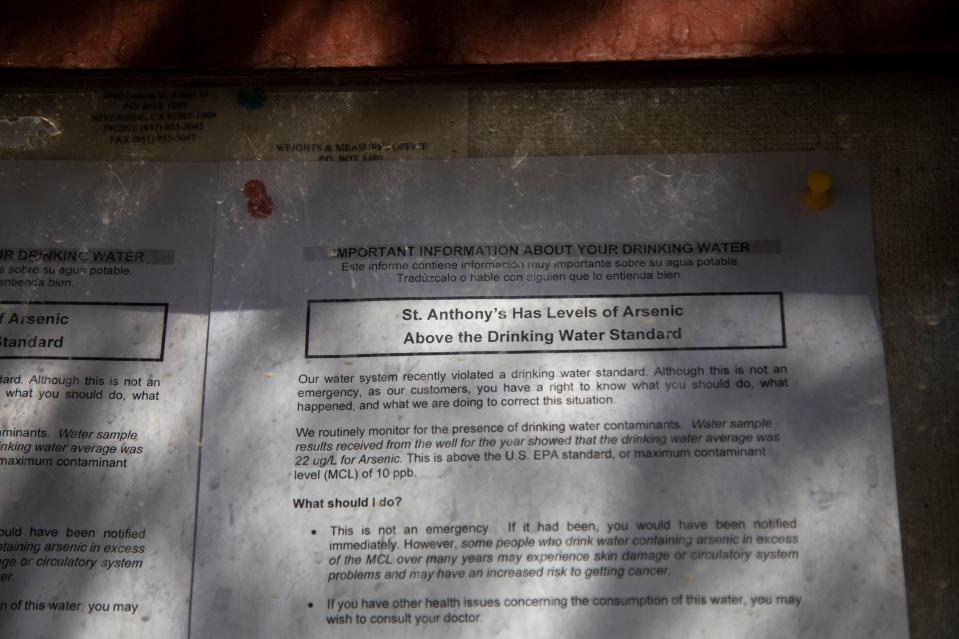
Senior EWG scientist Tasha Stoiber said the best filters to remove arsenic are reverse osmosis ones that typically go under a sink, but they don't work well if they are not installed properly, and can clog if not maintained.
Retirees Celia Vargas, 65, and her husband, Manuel, 77, have lived at St. Anthony for 17 years. They spend about $50 a month on jugs of water to drink, cook and wash their food and dishes. They still feel forced to use the faucet water to shower, as the cost and logistics of obtaining that much water would be too much.
Celia pointed to a small, red rash on one of her legs, and said she sometimes gets the spots on different parts of her body. She believes it’s from showering in contaminated supply.
“Sometimes the water smells bad and it’s foamy,” she said. Although the couple uses filters, they still have misgivings, with December 2021 signs from the Riverside County Department of Environmental Health and state water board still posted at the front of the park, warning it contains arsenic. Neither agency immediately returned requests for comment.
“Boil Your Water Before Drinking or Food Preparation to Avoid Illness,” the signs warn in bold. One also contains a recipe to add eight teaspoons of bleach per gallon of water if residents are unable to boil it. “Water may taste or smell like chlorine. This means disinfection has occurred,” they read, in English and Spanish.
Some residents fill buckets with water that is filtered on-site in a special storage unit, but not everyone has the physical strength to carry that supply to their home.
Few options
Most east valley residents have no choice but to stay where they are, with few affordable housing options. After officials relocated residents from the Oasis Mobile Home Park to brand-new affordable housing, the old Oasis units were filled by new occupants within months. EPA has issued orders against Oasis park owners three times since 2019, but the problems persist.
CVWD’s consultants found most people in eastern Coachella Valley mobile parks earn less — often far less — than the state's median household income level of $78,672. Families earning $60,188 or less qualify for a variety of funding programs that could eventually bring in enough dollars for safe, reliable water and sewage systems. But progress is bumpy.
CVWD staff say it could take another two years to build the first large water lines to top- priority parks, due to issues with supply chain logistics, obtaining right-of-ways and legally required reviews.
On Tuesday, CVWD's board approved a revised environmental document two years after its initial approval. Although less than a mile of 30-inch pipe is needed to hook up nine east valley mobile home parks to reliable water, that pipe will need to be dug in under Union Pacific railroad tracks and the large Whitewater River storm channel, with myriad required agreements and permits.
Ruiz, for one, says he’s not giving up. He’s marshaling federal infrastructure funds, possible Bureau of Indian Affairs and U.S. Dept. of Agriculture monies and any other resources he can find to get the first large projects moving for the east valley.
“In my experience, tackling insurmountable and complex issues is best done by tackling them one goal at a time,” he said. “Because once you have success, it breeds success."
Janet Wilson is senior environment reporter for The Desert Sun, and co-authors USA Today's Climate Point newsletter. She can be reached at jwilson@gannett.com or @janetwilson66 on Twitter.
Eliana Perez covers the eastern Coachella Valley, including the cities of Indio and Coachella. Reach her at eliana.perez@desertsun.com or on Twitter @ElianaPress.
This article originally appeared on Palm Springs Desert Sun: East Coachella Valley mobile home parks: arsenic water, sewage pits

